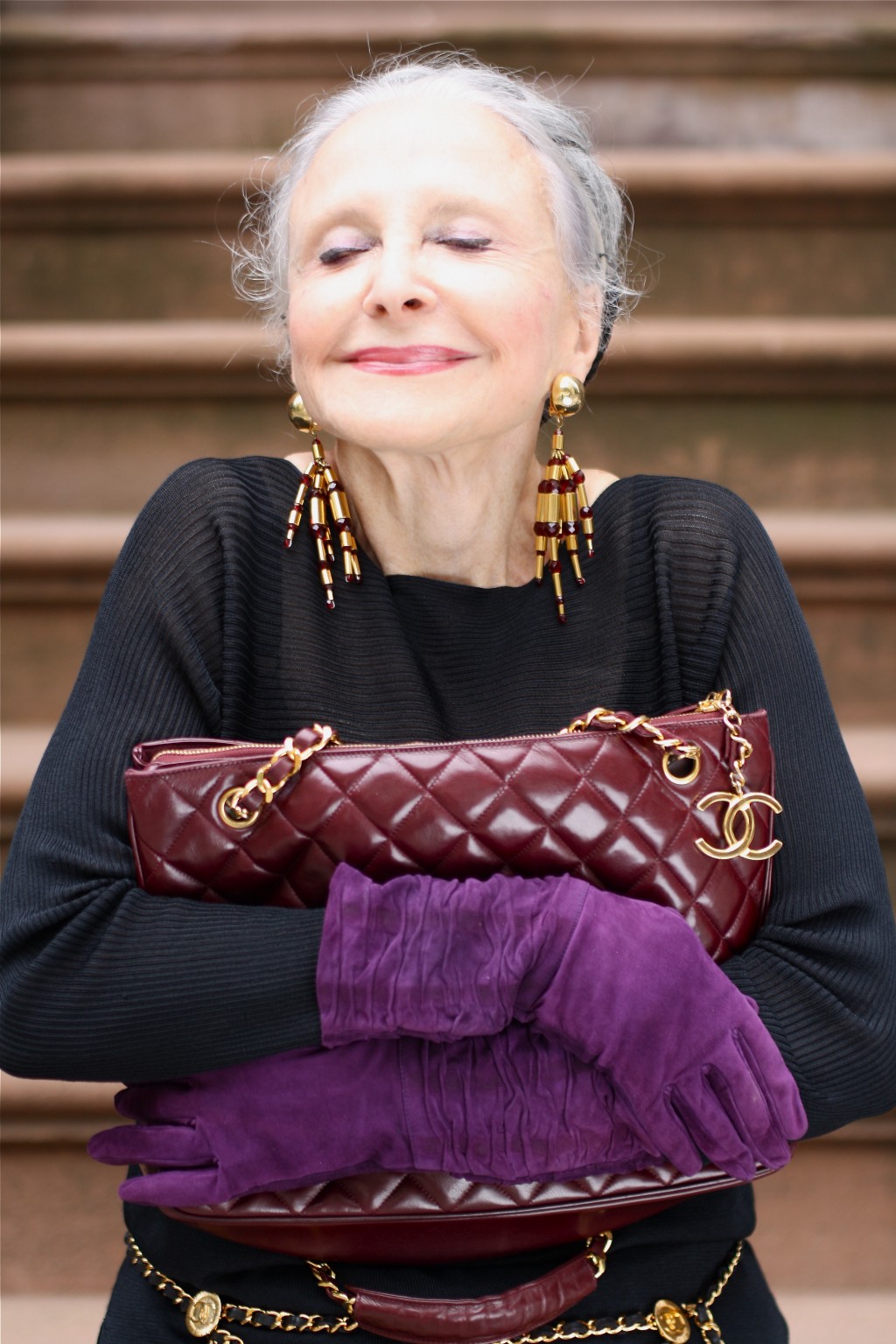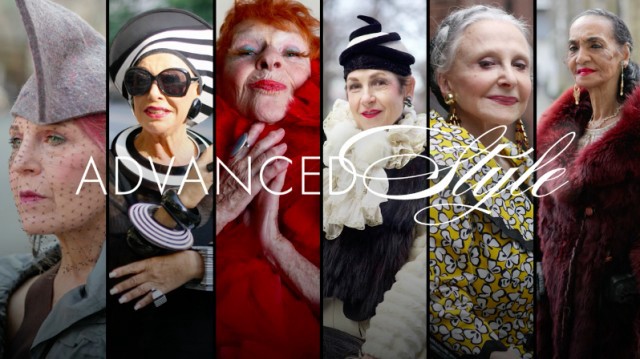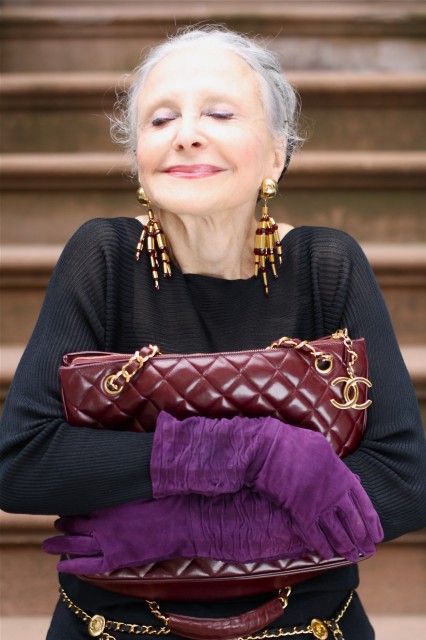An Interview with Lina Piloplyte, Director of Advanced Style


In 2010, filmmaker Lina Piloplyte teamed up with Ari Seth Cohen to create short films of the subjects of “Advanced Style,” Cohen’s style blog women over 50. The short videos were wildly successful, and after the release of both a coffee table book and a coloring book, the pair Kickstarted a campaign to fund a full-length documentary, raising over $20,000 more than their goal.
The film premiered in New York last Friday, and is on its way to theaters across the country; I talked to Lina briefly the morning of the premiere. Here’s my grandma’s review, emailed to me last week after we watched it together: “Thanks for thinking of me with the documentary. I can certainly identify with those seasoned ladies and the DRESS, WOW, I love it. It’s my kind of style. I love the vintage look. You know of any places in NY that I can shop?” Get inspired.
You moved to NYC in 2007, and you met Ari soon after. What brought you here?
I was studying journalism, completed my degree, and came over to NYC. I’m not one of those people who came to New York to make it! I just loved it so much that I stayed. It felt like home. I didn’t have a grand plan for working for a great filmmaker or anything, I just liked it here. I like that you have to haul ass, and you have to be on top of your game. I love that all of your heroes are here, and you can bump into them anywhere. These streets are iconic, and you see the most incredible characters.
I came for an MTV internship, and then I got a NYLON internship, and then I got a job doing videos for NYLON, which is where my love for fashion really started. There was full access to Fashion Week, designers, models, to new events, and it was amazing. I had to make videos about it and I got paid to do that! It was a dream job! It was a bootcamp for me, and it was a great experience.
And the blog began soon after, in 2008, so by the time you and Ari decided to make the film, there were a multitude of women that had been featured. How did you two decide how to narrow down the women to focus?
That was a process: we started off filming between 10 and 13 women and only some of them ended up in the film. It really depended on how much the women opened up, how much they’d let us into their home, and how intimate our bonds got. It was started being clear who was going to be in it, especially when the women started meeting one and another, and they started building a small community. You could start to see mini-families being shaped, and they became ambassadors for the Advanced Style world. Those were the ones who became stars of the film.

What was your goal in making the film?
I did not want an “old people movie” with ragtime and black-and-white photos of New York, and a big feeling of “that was then.” These women are more connected with New York today than I am — they’re always going to exhibitions or shows or dinners. They always know what’s going on. The film is all about today, it’s all about the modern and current. I tried to make a colorful and modern film that was relevant, and not an eye into the past.
The feeling that I got when hanging out with these women every day is to just go and do it and be myself and be free and fearless. All I wanted to do is to make that visible to the audience. Dressing up is only one small part of the way they live their lives. They’re all very strong invdividuals, through and through — they way they eat or act or do anything. They’re colorful inside and out. I found myself with answers to questions about aging, and even though we approached it through clothing, the outcome is much deeper.
The film itself is really beautifully shot, sort of like Wes Andersen meets Vogue. How did you decide on this particular style?
I think it just came out of who I am naturally and who these women are. It was all about texture and richness and color and surroundings — there aren’t any white walls in the movie! We’re always surrounded by little details — earrings, scarves, everything in their world. Accessories, everywhere. Everything around them is texture, so it was important to me to show that in the film. We had to reflect every single one of them so it was like hmm, what would speak to this particular woman? Let’s do something really flashy for her.
You’ve mentioned in a press junket that you have a fear of aging. Did working on the documentary help?
I have a healthier approach to it than I used to. I’ve always had an incredible respect and love for older people — I was what people call an old soul. I’d always talk to the older people at the parties! But when I was younger, all the media concepts about aging and wrinkles and sagging and how you have to stop all of that immediately and how you have to prevent any signs of aging because it’s supposed to be worst thing to happen to a woman really affected me. At 25, I was very concerned! The future seemed kind of dark.
But hanging out with the women, it was like holy cow, it looks like 65 and up are the best years of your life. It’s like a big party. What’s important about the film is that we’re not lying to get there — there’s pain with getting older. It’s not always easy. You’re not as flexible as you once were. But you can have so much freedom, and you can be whomever you want, and you can still be in the limelight and you can do whatever you want. I don’t like the concept that people are old when they’re 50 — these women are 80! I was raised with a waiting-for-death-to-arrive view of aging, but these women are dancing ’til the last moment. It was really eye-opening and life-affirming. It’s not even about style or age, it’s just how to live every day in that kind of inspiring way. They do a lot of positive thinking — they wake up and say, “this is going to be a great day!” Why the hell wouldn’t it be?
Right! What blew me away about the film about how confident these women were, especially Ilona, aged 93 in the film, who is the oldest woman profiled.
The craziest thing is that Ilona was not confident at all until her 80s. She was an artist, and produced an incredible amount of work, but she’s always felt that she was worse than anyone else and totally insecure. She has an incredible approach to life — she’s a Buddhist teacher without being a Buddhist!
And we get to see how she makes her own eyelashes, which is nuts. How close are you with the women?
Right now I see them every day. I’m on my way to see Ilona, actually, because she requested that I come by. She’s one of the people that became my life advisor, my shrink — she has consoled my broken heart so many times. She’s an incredible presence. She somehow shows that the small stuff doesn’t really matter — look up to the sky, look at this tree, isn’t life beautiful? That just oozes from her. Deborah, another woman — she’s become like my mother. We’re both Lithuanian and yesterday we had a Jewish new year celebration at her house. She made a fantastic amount of healthy food, and she checked in on me. She and I can talk about anything — issues and feelings of an artist, how to be creative. I’ve formed these deep bonds with a lot of them. It’s generally a no no for a filmmaker to become friends with the subject, but I think I stayed objective when it came making the movie, but you can’t help to fall in love with them. They changed my whole perspective of aging — I’m less fearful of aging now at 31 than I was at 25 when I started this project. If people watch this and have a tiny bit of what I now feel, the message is there.
So, as stylish as you are now: if you were going to be honored with a wax figure at Madame Tussaud’s, what would you wear?
Hah! It would be leopard skinny pants, and a sparkle blazer on top. The one I’m wearing right now, actually.
Images courtesy of Ari Seth Cohen.